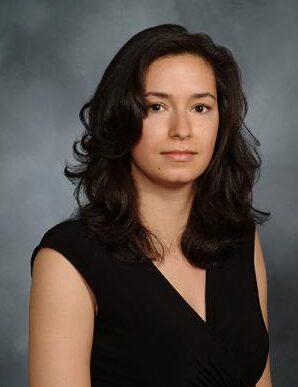What is Breast Density?
A radiologist specializing in breast imaging at NewYork-Presbyterian/Weill Cornell Medical Center explains what to know about breast density, a risk factor for breast cancer.

The term breast density has been in the news lately, with the U.S. Food and Drug Administration requiring that people be notified of their breast density as part of their mammogram results. And a new study published in JAMA Oncology found that a slower rate of change in breast density is associated with a higher risk of developing future breast cancer.
But what exactly is breast density? “Breasts are composed of two main elements: fibroglandular breast tissue and fat. Our breasts are made of different proportions of the two,” explains Dr. Katia Dodelzon, a radiologist specializing in breast imaging at NewYork-Presbyterian/Weill Cornell Medical Center. “Breast density is a measure of fibroglandular tissues compared to the amount of fatty tissue.”

Dr. Katerina Dodelzon
Breast cancer is the most common cancer among women in the United States, aside from skin cancer, according to the American Cancer Society, which lists breast density as a risk factor for developing the disease. Breast cancer accounts for about 30% of all new female cancers each year.
“Breast density information is valuable for risk assessment and ultimately helps guide efforts toward personalized breast cancer care,” adds Dr. Dodelzon, who is also an associate professor of clinical radiology at Weill Cornell Medicine.
Health Matters spoke with Dr. Dodelzon to better understand breast density and why women should know about it.
What does it mean to have dense breast tissue? Is it common?
Dr. Dodelzon: Dense breasts have high amounts of fibroglandular tissue and low amounts of fatty tissue. Having dense breast tissue is both common and normal—about 50% of women in the U.S. 40 years or older have dense breast tissue.
After a mammogram, you will get a letter that will describe your results, such as if they are normal or require additional evaluation. Another component of the letter, as required by the U.S. Food and Drug Administration, will include your breast density information. Mammogram centers will discuss breast density results with you and recommend speaking further with your doctor about breast density and breast cancer risk.
What to Know About Breast Density Categories
When you receive your mammogram report letter, your breast density results will be one of four categories. They include:
- Fatty: the breast is made up of mostly fatty tissue.
- Scattered: there is half the amount of fat and half the amount of fibro and glandular tissue in the breast.
- Heterogeneously dense: the breast has many areas of dense fibro and glandular tissue, and some areas of fatty tissue.
- Extremely dense: the breast is made up almost entirely of fibro and granular tissue.
In the U.S., breast density is of normal distribution among women. Normal distribution means that 10% are fatty and 10% are in that extremely dense category, while the rest, 80%, are scattered, or heterogeneously dense. If you take an average, women are somewhere in between the scattered and heterogeneously dense categories.
How is breast density determined?
Radiologists determine breast density by evaluating a mammogram, an X-ray image used to screen for early signs of breast cancer.
Average-risk women should begin screening for breast cancer starting at age 40, as supported by recommendations of experts in the field, including the American Cancer Society, American College of Radiology/Society of Breast Imaging, among others, and as per new recommendations from the U.S. Preventive Services Task Force.
Annual breast cancer screening has the greatest reduction in breast cancer-related death and saves the most lives.
Why is it important for people to know their breast density?
Dense breast tissue on a mammogram can mask breast cancer on a mammogram. Heterogeneously dense or extremely dense tissue appears white on a mammogram image and can mask or blend in with tumors, which also show as white. Fatty tissues appear black.
Independent of this, dense breast tissue also increases the risk of breast cancer. Multiple studies demonstrate at least a moderate association between mammographic breast density and breast cancer risk, with women who have higher mammographic breast density (considered the heterogeneously dense and extremely dense groups) carrying a greater lifetime risk of developing breast cancer compared to women who have mammographically fatty or scattered density.
Screening with supplemental imaging in addition to mammograms is therefore encouraged if someone has dense breast tissue. Additional methods to screen for breast cancer include ultrasounds and MRIs.
What factors influence breast density?
Breast density is specific to each person and is influenced by various factors, including genetics, age, having given birth, body mass index, menopausal status, and hormone replacement therapy, which increases the length or amount of exposure to female hormones, such as estrogen and progesterone.
For example, dense breasts can be associated with being younger than 50, and with a low body mass index. Breast density tends to decrease as women get older.
What did the study in JAMA Oncology find?
In the study, 10,481 women who were without symptoms and cancer-free when the study began were observed from November 2008 to October 2020. During the 12-year period, they had routine mammograms every one to two years, where changes to their breast density were monitored over time.
There were 289 women who developed breast cancer. At the start of the study, breast density was higher in the participants who ended up being diagnosed with breast cancer, and over time, their density declined.
But when researchers analyzed mammogram images separately for each breast, they found a new element to breast density: it declined significantly slower in the breast where participants later developed breast cancer.
Why are these findings important?
These findings are important because participants were followed for over 10 years and suggested that breast density is not a static risk factor — it is dynamic and can change over time.
Decreasing breast density lowers breast cancer risk, but the rate of decrease appears to provide additional, more nuanced, and dynamic information on the potential risk of developing breast cancer.
The information we gather from a mammogram, such as your breast density category and now potentially the rate of breast density changes, as observed in mammograms over time, is and should be taken into consideration when assessing breast cancer risk over a woman’s lifetime. This can help inform the most appropriate and personalized screening strategies for each woman.
Katerina Dodelzon, M.D., is a board-certified radiologist specializing in breast imaging and an assistant attending radiologist at NewYork-Presbyterian/Weill Cornell Medical Center. She is an associate professor of clinical radiology at Weill Cornell Medicine, Vice Chair of Clinical Operations for the Department of Radiology and serves as the associate program director of the Breast Imaging Fellowship Training Program.
